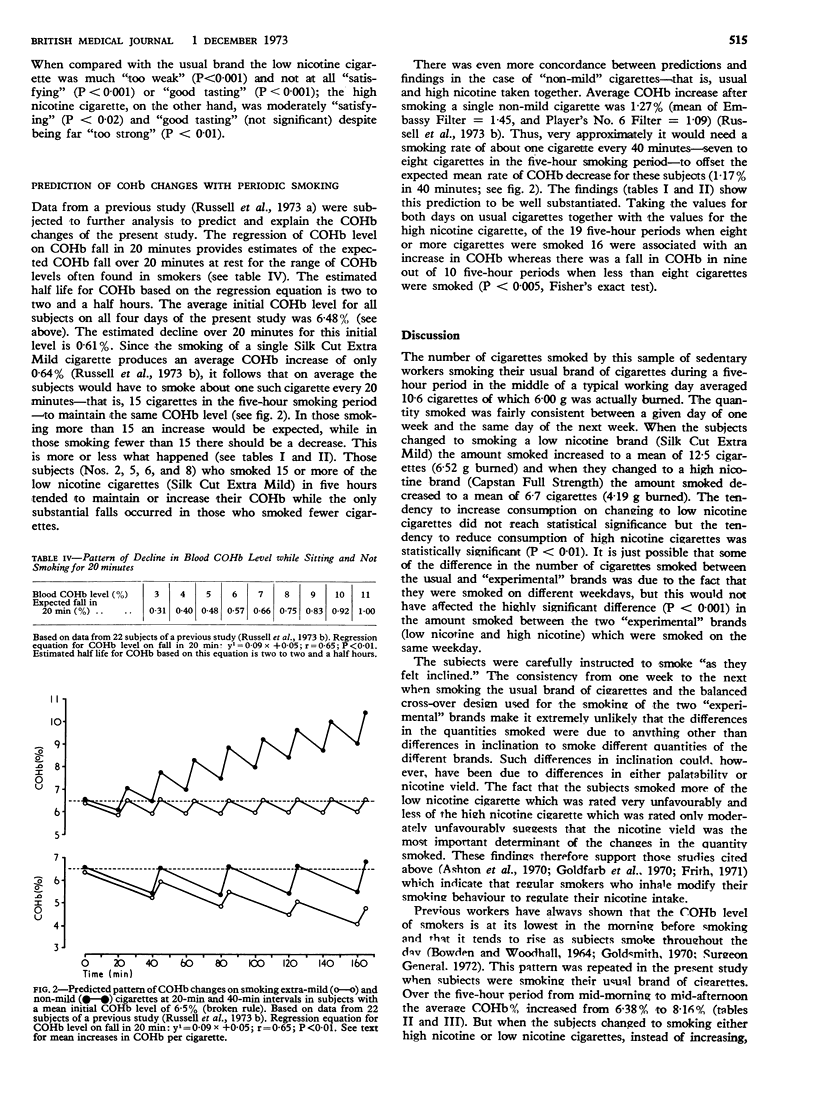Abstract
In 10 sedentary workers, smoking as they felt inclined over a five-hour period in the middle of a typical working day, changing to low nicotine cigarettes (<0·3 mg) caused an increase in the number and weight of cigarettes smoked, while changing to high nicotine cigarettes (3·2 mg) caused a decrease (P < 0·01). The average number and weight smoked in five hours for usual, low, and high nicotine brands were respectively 10·6 (6·00 g), 12·5 (6·52 g), and 6·7 (4·19 g). When smoking the usual brand the average blood carboxyhaemoglobin (COHb) increased 1·78% (from 6·38% to 8·16%). But on changing to either high or low nicotine cigarettes the COHb levels instead of increasing, tended to fall (P < 0·01). The average fall of 0·34% while smoking low nicotine cigarettes was due to the low carbon monoxide (CO) yield of these cigarettes, while the fall of 1·04% when smoking high nicotine cigarettes was attributable to reduced consumption. The findings support the view that smoking behaviour is modified to regulate nicotine intake. Besides having low tar and CO yields, the least harmful cigarettes for heavy smokers may be those with a high, rather than low, nicotine yield.
Full text
PDF




Selected References
These references are in PubMed. This may not be the complete list of references from this article.
- Aitken R. C. Measurement of feelings using visual analogue scales. Proc R Soc Med. 1969 Oct;62(10):989–993. [PMC free article] [PubMed] [Google Scholar]
- Ashton H., Watson D. W. Puffing frequency and nicotine intake in cigarette smokers. Br Med J. 1970 Sep 19;3(5724):679–681. doi: 10.1136/bmj.3.5724.679. [DOI] [PMC free article] [PubMed] [Google Scholar]
- Frith C. D. The effect of varying the nicotine content of cigarettes on human smoking behaviour. Psychopharmacologia. 1971;19(2):188–192. doi: 10.1007/BF00402641. [DOI] [PubMed] [Google Scholar]
- Goldfarb T. L., Jarvik M. E. Accomodation to restricted tobacco smoke intake in cigarette smokers. Int J Addict. 1972;7(3):559–565. doi: 10.3109/10826087209028108. [DOI] [PubMed] [Google Scholar]
- Goldfarb T. L., Jarvik M. E., Glick S. D. Cigarette nicotine content as a determinant of human smoking behavior. Psychopharmacologia. 1970;17(1):89–93. doi: 10.1007/BF00402094. [DOI] [PubMed] [Google Scholar]
- Goldsmith J. R. Contribution of motor vehicle exhaust, industry, and cigarette smoking to community carbon monoxide exposures. Ann N Y Acad Sci. 1970 Oct 5;174(1):122–134. doi: 10.1111/j.1749-6632.1970.tb49779.x. [DOI] [PubMed] [Google Scholar]
- Russell M. A. Cigarette smoking: natural history of a dependence disorder. Br J Med Psychol. 1971 Mar;44(1):1–16. doi: 10.1111/j.2044-8341.1971.tb02141.x. [DOI] [PubMed] [Google Scholar]
- Russell M. A., Cole P. V., Brown E. Absorption by non-smokers of carbon monoxide from room air polluted by tobacco smoke. Lancet. 1973 Mar 17;1(7803):576–579. doi: 10.1016/s0140-6736(73)90718-6. [DOI] [PubMed] [Google Scholar]
- Russell M. A., Wilson C., Cole P. V., Idle M., Feyerabend C. Comparison of increases in carboxyhaemoglobin after smoking "extra-mild" and "non-mild" cigarettes. Lancet. 1973 Sep 29;2(7831):687–690. doi: 10.1016/s0140-6736(73)92533-6. [DOI] [PubMed] [Google Scholar]
- Waingrow S., Horn D. Relationship of number of cigarettes smoked to "tar" rating. Natl Cancer Inst Monogr. 1968 Jun;28:29–33. [PubMed] [Google Scholar]


